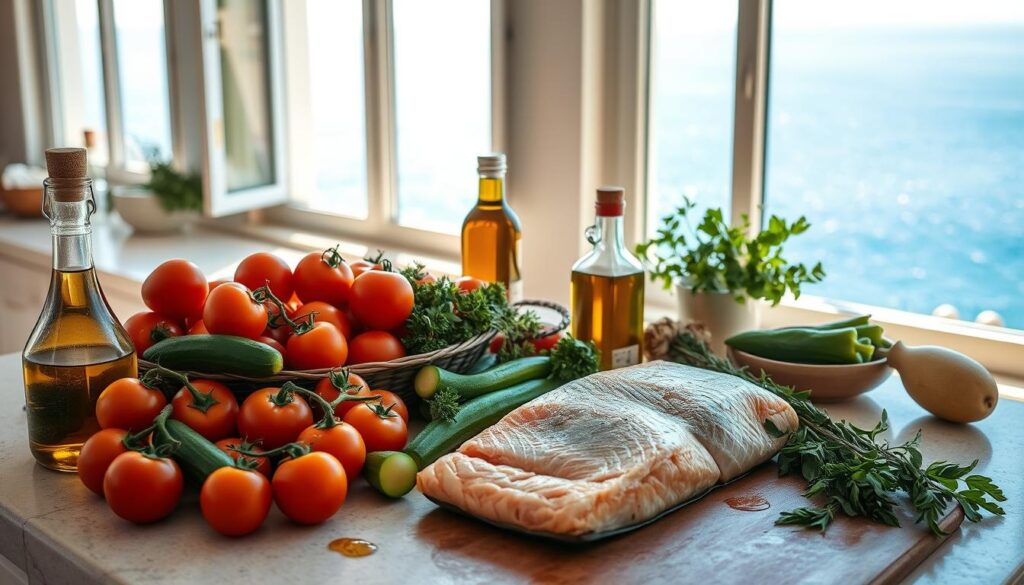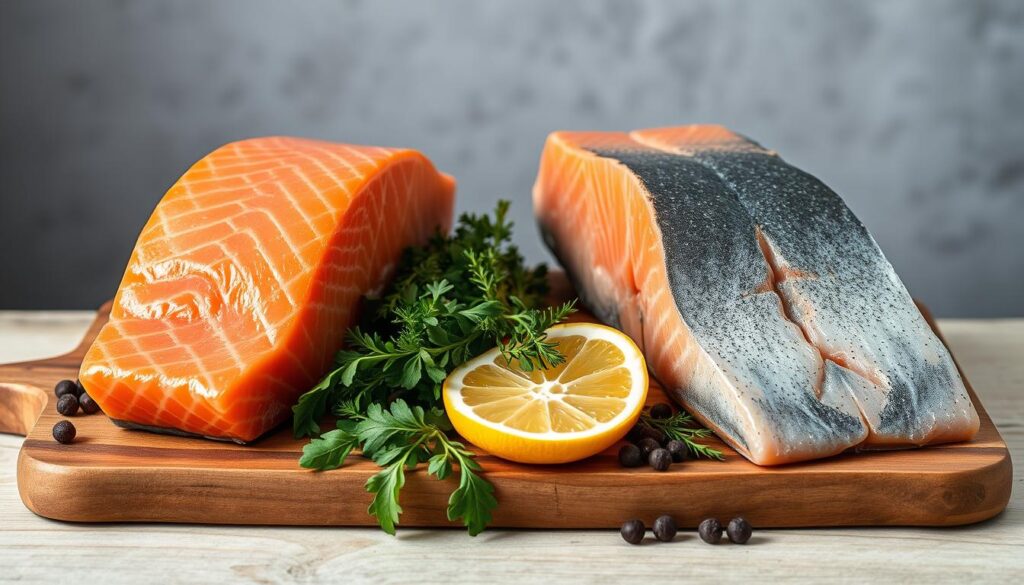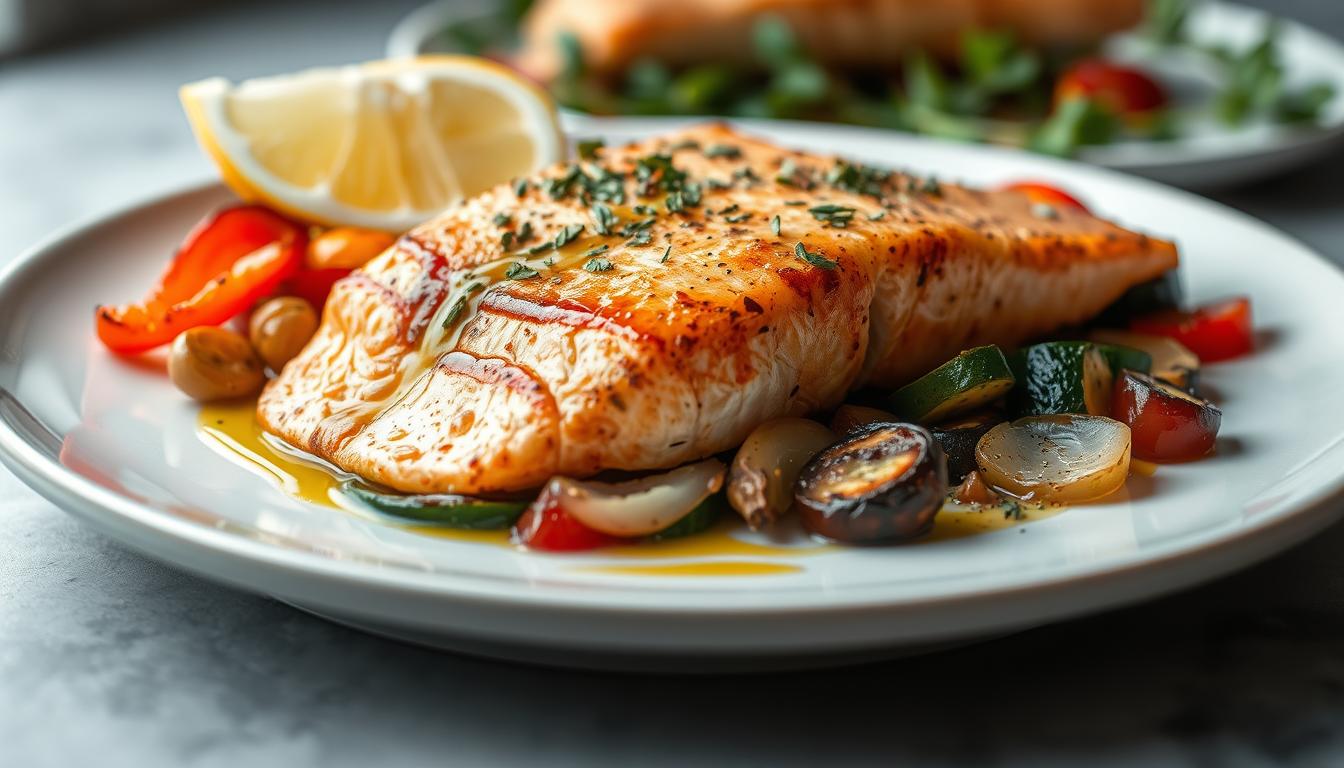Top Mediterranean Diet Salmon Recipes for a Healthy Lifestyle
Top Mediterranean Diet Salmon Recipes for a Healthy Lifestyle
Imagine this: You’re hosting a family dinner, and your cousin—who swears they don’t like fish—takes one bite of your lemon-garlic baked fillet. Suddenly, they’re asking for seconds. That’s the magic of wild-caught fish prepared with vibrant herbs and simple techniques. It turns skeptics into fans while keeping meals nutritious and effortless.
What makes these dishes stand out? They blend quality protein with bold flavors like oregano and smoked paprika. Wild varieties shine here—their silky texture holds up beautifully whether you’re grilling, roasting, or wrapping them in foil. Plus, they’re packed with omega-3s and vitamin D, aligning perfectly with heart-healthy eating habits.
This guide walks you through selecting the best cuts, mastering oven-baked methods, and pairing meals with creative sides like roasted sweet potatoes. You’ll discover how to turn weeknight dinners into flavorful experiences that even picky eaters will love. Ready to transform your table?
Table of Contents
Key Takeaways
- Wild-caught fish offers superior texture and nutrients compared to farmed options
- Bright citrus and herb combinations make meals appealing to diverse tastes
- Foil-wrapped baking locks in moisture for tender, flaky results every time
- Sheet-pan methods simplify cleanup while roasting proteins and veggies together
- Omega-3 fatty acids in these dishes support brain and heart health
Discover the Mediterranean Diet and Its Health Benefits
What if your meals could boost heart health while delighting your taste buds? This eating pattern focuses on whole foods like fresh produce, olive oil, and seafood. It’s not just about what you eat—it’s a celebration of mindful cooking and shared moments around the table.

About the Mediterranean Lifestyle
At its core, this approach prioritizes quality over quantity. Think grilled fish drizzled with lemon juice, roasted veggies seasoned with oregano, and salads bursting with color. Regular physical activity and enjoying meals with loved ones are just as important as the ingredients themselves.
Weekly menus often feature omega-3-rich options like wild-caught fish. These proteins pair perfectly with antioxidant-packed sides—imagine garlic-roasted broccoli or quinoa tossed with fresh parsley. Even weeknight dinners become opportunities to nourish both body and relationships.
Key Health Benefits & Nutritional Insights
Studies show this way of eating supports brain function and reduces inflammation. The magic lies in combining lean proteins with herbs like basil, which add flavor without excess salt. Dishes prepared in the oven retain more nutrients compared to frying, making every bite count.
Want to maximize benefits? Try adding a squeeze of citrus to your next fish dish. The vitamin C helps your body absorb iron from plant-based foods. It’s these simple, intentional choices that transform ordinary recipes into lifelong wellness habits.
Selecting the Perfect Salmon: Wild vs. Farmed
Not all salmon is created equal—discover what sets wild-caught apart. The choice between wild and farmed varieties impacts flavor, texture, and nutritional value. Let’s break down why your selection matters.

Why Wild Salmon Wins Nutritionally
Wild fish thrive in natural environments, developing leaner bodies with 34% more omega-3s than farmed options. Their vibrant orange-pink hue comes from astaxanthin, a powerful antioxidant absent in artificially colored farmed fillets. You’ll notice thinner cuts and silkier texture that cook faster while retaining moisture.
Farmed varieties often contain added dyes and higher fat content—11 grams per serving versus 7 grams in wild. This affects both taste and health benefits. For recipes prioritizing clean flavors, wild-caught delivers unmatched quality.
Master these cooking techniques to highlight its natural advantages:
- Wrap fillets in foil with lemon slices to lock in juices during oven roasting
- Bake at 145°F until flesh flakes easily with a fork
- Pair simple seasonings like cracked pepper or fresh oregano
Pro tip: Wild salmon cooks 2-3 minutes faster than farmed due to lower fat content. Watch the clock to avoid dry results. Whether grilled or baked, its rich flavor shines through minimal preparation—perfect for quick weeknight meals.
Top mediterranean diet salmon recipes for a Healthy Lifestyle
Transform your kitchen into a coastal bistro with these vibrant dishes. Each creation balances bold spices with smart techniques that preserve nutrients while maximizing taste. Let’s explore crowd-pleasing options that work whether you’re hosting guests or feeding hungry kids.
A Must-Try Listicle of Flavorful Recipes
These seven standout ideas cater to diverse preferences:
- Lemon-Herb Foil Packets: Zesty citrus meets oregano and thyme, steamed to flaky perfection in 12 minutes
- Smoky Paprika Grilled Fillets: Charred edges with a hint of spice, ideal for outdoor cooking
- Garlic-Dill Sheet Pan Supper: Roasted alongside asparagus and cherry tomatoes for effortless cleanup
- Citrus-Marinated Skewers: Cubed fish alternated with pineapple chunks, grilled until caramelized
Integrating These Recipes into Your Weekly Meal Plan
Swap chicken or beef with these protein-rich options twice weekly. Prep foil packets Sunday night for Tuesday’s dinner—they refrigerate beautifully. For last-minute meals, try the 15-minute garlic-butter variation: sear seasoned fillets, then finish with lemon juice.
Pair any dish with roasted sweet potatoes or a parsley-flecked quinoa salad. Check doneness by gently pressing the flesh—it should spring back slightly. Leftovers? Flake cooled fish into tomorrow’s lunch wrap with tzatziki and crunchy veggies.
Sheet-Pan and Oven-Baked Salmon Delights
Weeknight dinners just got smarter. Picture this: juicy fillets roasting alongside colorful veggies while you relax. This method turns chaotic evenings into stress-free meals with minimal effort.
Why Sheet-Pan Cooking Wins
One pan. Zero fuss. Toss seasoned fish and veggies like cherry tomatoes onto parchment paper—no scrubbing later. Hot ovens crisp skin while locking in moisture. You’ll spend more time eating than cleaning.
Foolproof Oven Techniques
Preheat to 400°F. Rub fillets with olive oil, then sprinkle garlic and cracked pepper. Arrange lemon slices on top. Roast 12-15 minutes. Pro tip: Slide a fork into the thickest part—if it flakes easily, it’s done.
Cleanup Hacks That Work
Line pans with foil under parchment for double protection. Roast potatoes first, then add fish and quick-cooking veggies like asparagus. Everything finishes together. Leftover herbs? Freeze them in olive oil cubes for next time.
“Sheet-pan meals turn cooking into assembly,” says a busy parent from Texas. Combine bold flavors like basil and Kalamata olives for Mediterranean-inspired twists without extra dishes. Your future self will thank you.
Lemon Garlic and Bold Flavored Salmon Ideas
What separates good fish dishes from unforgettable ones? The answer lies in bright citrus punches balanced with aromatic herbs. Our signature lemon-garlic creation transforms weeknight cooking into a flavor adventure while keeping prep under 20 minutes.
Enhancing Flavor with Citrus and Herbs
Mix 2 tbsp lemon zest with ¼ cup olive oil, 3 minced garlic cloves, and 1 tsp each oregano and smoked paprika. This vibrant sauce gets brushed over fillets before wrapping them in foil. “The foil packet method keeps every bite juicy,” notes a home cook from Florida. Bake at 375°F for 12-15 minutes until the flesh flakes easily.
Pair with a herbed yogurt sauce: combine Greek yogurt, fresh dill, chopped parsley, and a garlic clove. The cool tang complements the zesty fish perfectly. For crispier edges, broil unwrapped fillets during the last 2 minutes.
Variations to Suit Different Palates
Swap lemon for lime in the marinade for tropical vibes. Prefer milder flavors? Use basil instead of oregano. Add ½ tsp cumin or chili powder for depth. Love heat? Sprinkle red pepper flakes before baking.
Watch cooking times closely—wild-caught varieties cook faster than farmed. Test doneness by pressing the thickest part; it should spring back slightly. Leftovers shine in tacos or grain bowls, proving versatility matters as much as initial flavor.
Creative Sides & Salads to Accompany Your Salmon
Your perfectly cooked fillet deserves companions that match its vibrancy. Bright salads and hearty sides transform simple meals into feasts for the senses. Let’s explore pairings that balance textures and amplify flavors without overshadowing your main dish.
Fresh Combinations That Sing
Try a crunchy fattoush salad with romaine, radishes, and homemade za’atar pita chips. Toss in Persian cucumbers and sumac-marinated onions for tangy depth. “The crunch of fresh veggies cuts through the richness of olive oil-dressed fish,” notes a chef from California.
For lighter options, mix cherry tomatoes with crumbled feta and lemon-dill dressing. Add toasted pine nuts for nutty contrast. These salads prep in 10 minutes yet taste like they came from a seaside café.
Heartier Pairings for Balance
Roasted garlic potatoes with rosemary offer crispy comfort. Or try lemon-kissed green beans sautéed with slivered almonds. Both sides cook in one pan while your protein rests.
Complete your plate with:
- Herbed quinoa pilaf studded with dried apricots
- Smoky paprika roasted carrots
- Creamy hummus swirled with harissa
Drizzle everything with garlic-lemon sauce for cohesive flavor. Arrange components in colorful sections on platters—it makes weeknight dinners feel special. Experiment with mint or oregano in dressings to keep meals exciting.
Cooking Tips to Perfect Your Mediterranean Salmon Dish
Perfectly cooked fish separates kitchen novices from confident home chefs. The secret? Precision with heat management and timing. Let’s break down professional techniques that guarantee tender, flaky results every time.
Mastering Cooking Time and Temperature
Preheat your oven to 400°F—position racks centrally for even airflow. Wild-caught fillets cook faster than farmed, so adjust times: 10-12 minutes for thinner cuts versus 15 for thicker ones. Use an instant-read thermometer; aim for 120-130°F internally. “The fish keeps cooking after removal,” notes a culinary instructor. Let it rest 5 minutes—residual heat completes the process without drying.
Avoiding Overcooking for Flaky Perfection
Wrap fillets in foil or parchment to trap steam. Check doneness by gently separating layers with a fork—opaque pink flesh signals readiness. For crispy edges, broil 1-2 minutes after baking. Common mistakes? Overcrowding pans and ignoring thickness variations. A 1.5-inch fillet needs 3-4 more minutes than a 1-inch cut.
Quick fixes save overcooked dishes: drizzle lemon-garlic sauce to add moisture. Always pat fillets dry before seasoning—excess water steams instead of searing. With these methods, you’ll transform simple ingredients into restaurant-quality meals effortlessly.
Conclusion
Revamp your weekly menu with dishes that delight and nourish. By choosing wild-caught options and mastering oven techniques, you unlock meals rich in omega-3s and vibrant flavors. Foil packets keep fish tender, while zesty lemon-garlic sauces add brightness without fuss.
Pair these proteins with roasted potatoes or crisp green beans for balanced plates. Whether it’s a Tuesday dinner or weekend gathering, these methods save time and impress guests. Remember: proper heat management ensures flaky results every time.
Don’t hesitate to experiment—swap herbs like oregano for parsley or try new sides. Your journey to healthier eating starts here, one simple recipe at a time. Revisit these tips whenever you need inspiration for turning quality ingredients into memorable meals.

